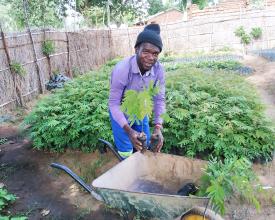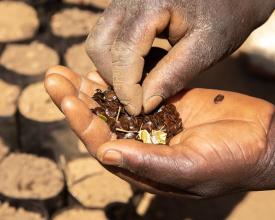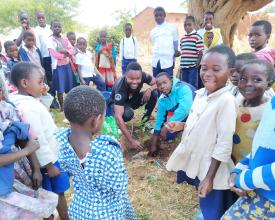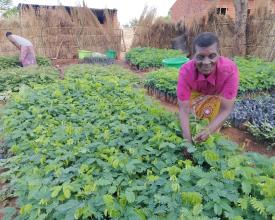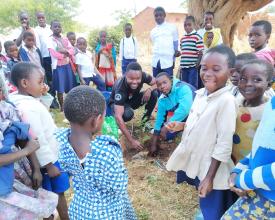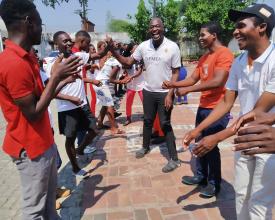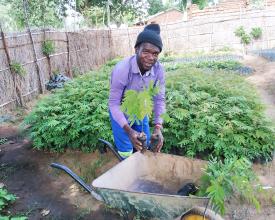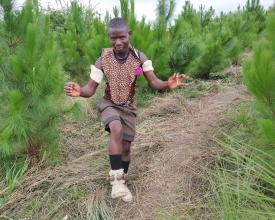
Chuma Chathu Forest and Land Restoration Focusing on Children in the Kirk Range Mountains
Agriculture, a major economic activity accounting for 91% of income, is the primary land use in Ntcheu District, which is predominantly rural. Despite this, 97% of farmers practice subsistence farming with an average landholding of 1 hectare per household. The district is facing rampant deforestation and environmental degradation, threatening the ecological balance and well-being of its residents. The loss of forest cover leads to soil erosion, diminished water quality, and biodiversity loss, exacerbating poverty and food insecurity.
To combat these challenges, Environmental Education programs have been introduced in schools around the Kirk Range Mountains. These programs include the establishment of woodlots and orchards and the promotion of climate-smart agriculture in both school gardens and the community. Youths play a key role in raising awareness, while community members receive comprehensive training on sustainable forestry practices, agroforestry techniques, and biodiversity conservation.
Context
Challenges addressed
Agriculture is considered a major economic activity accounting for 91% of income though done at a very small scale followed by small-scale trading (10%). 97% of the farmers practice subsistence farming with an average land holding size of 1 ha per household and heavily rely on the same for income. The loss of forest cover contributes to soil erosion, diminished water quality, and biodiversity loss, exacerbating poverty and food insecurity.
Location
Process
Summary of the process
Developing and implementing a program that is people-centred through community management, youth engagement and awareness raising is paramount for program ownership and sustainability. Awareness raising about the environmental issues the community is facing and agreed possible solutions championed by the youths ensures that the community takes a leading role in the management of the program.
Building Blocks
Building Block 1- Community Management
The program is community-driven which means the youths in schools and youth clubs, as well as community members, especially women in natural resource management committees, are both participants in, and beneficiaries of, restoration efforts. The program enjoys great support from the Traditional Leaders. The community decides where restoration should be done, and how and when it should be done. This approach ensures community ownership and sustainability of the program.
Enabling factors
The community should be leading the process and be a key part of the activities throughout the program.
Engaging early with the Traditional Leaders in the community, allows buy-in and has enabled the youth club’s to be successful. For example the Traditional Leaders allocated pieces of land in the mountains to youth’s within the community, for them to protect and manage.
Active participation of women, allows the effective establishment of the tree nurseries which the women in the community manage and sustain, this enables them to apply their knowledge on natural regeneration and agro-forestry practically, which enabled these practices to be used them in their own land.
Directly involving the schools in the local area has enabled access to the youths, where we have been able to help support the young people in growing and managing tree nurseries and woodlots.
Lesson learned
Local knowledge and participation is crucial. They bring a sense of ownership, the communities feel part of the solution and more invested in its success, which makes the program impact more sustainable.
Building Block 2- Youth Engagement as Future Restoration Champions
The youths who constitute about half the population of Malawi mobilise themselves and get into youth clubs. They plan to address environmental issues that affect them directly and indirectly in their communities. This is an energetic and innovative category of people that focuses on shaping a better future through awareness raising in the community by use of arts such as drama, music, poems and community meetings. They work very collaboratively with traditional leaders who support them by giving them access to land for restoration, calling community members for community meetings and enforcement of community norms.
Enabling factors
Half of Malawi’s 17.6 million inhabitants who are youth aged 10-35 years should be organized in youth clubs to actively participate in the program. Youth clubs should identify degraded forests and land that need to be restored in collaboration with traditional leaders. The youths will raise tree seedlings, and plant and take care of them by protecting them from harmful bushfires, encroachment, and wanton cutting. School youths learn the restoration skills and practice them within the school with support from the school authorities.
Lesson learned
Understanding the huge future benefits of forest and land restoration motivates youths to actively participate and own the program. For example, apart from natural regeneration, Chibwana Youth Club plans to plant over 4000 pine trees every year in the Kirk Range Mountains that will help them when sold to build school blocks, provide them with capital to start small businesses, and pay school fees for needy students. That means the youths feel that they are not only program participants but also beneficiaries.
Building Block 3- Awareness Raising, as a Tool for Change
In order to achieve behaviour change among communities, well-crafted environmental restoration and climate-smart agriculture messages should be disseminated in a persuasive, exciting, and attractive way that is friendly to all and culturally accepted by respective communities. Well-known practical examples are demonstrated for easy understanding of the program.
Enabling factors
The youths will innovatively use their talents and available exciting resources to reach out to their audience which is the community with messages about climate-smart agriculture, forest, and land restoration, the negative impacts of land and forest degradation, and how they can collectively address the problem.
Lesson learned
The use of virtual media such as Forest and Land Restoration videos on the big screen (projector) and, use of arts such as drama and music draw a lot of community members to excitedly listen to messages that are being put across.
Impacts
There is notably enhanced biodiversity due to afforestation, natural regeneration, and agroforestry.
Increased household food security among 366 follower farmers alongside 135 lead farmers who were trained in various climate-smart agricultural technologies.
Reduced soil erosion due to improved and restored forest cover.
Improved knowledge and skills about forest and land restoration and climate-smart agriculture through training and biodiversity awareness.
Furthermore, the program strengthens community cohesion and collaboration.
Beneficiaries
Women and the youth from the impact communities, and children in schools participated in the program and enjoyed the increased food security, gained new knowledge and skills, reduced run-off, beautified scenery, easy access to fuel wood.
Sustainable Development Goals
Story
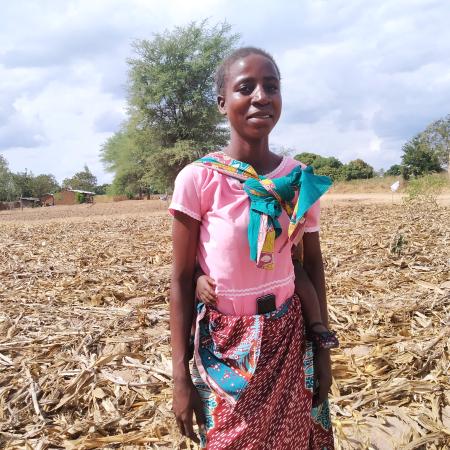
Meet Elizabeth Banda from Kukhola II Village in Traditional Authority Makwangwala in Ntcheu District, Malawi. Eliza is 30 years old and has 3 children. Eliza is one of the follower farmers who have adopted climate-smart agricultural technologies and took them into their own fields from the demonstration plots. From the very same land Eliza and her husband used to harvest 75kgs of maize before adoption of the climate-smart agricultural technologies she now harvests 500kgs of maize after adoption and practice of the climate-smart agricultural technologies. " I have toiled with very little returns for many years but now I get the best reward of my labour in the garden through Climate-Smart Agriculture. In her garden, Eliza applies compost and animal manure, constructed Swalleys to harvest the most scarce rain water and reduce run-off, practices pit-planting, agroforestry and mulching.
